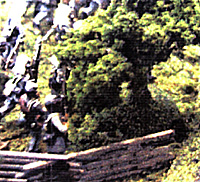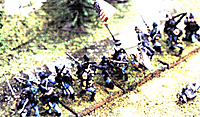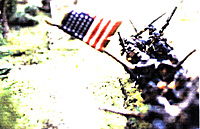 It is hard to find an American battlefield that was
not crisscrossed with some form of streams, creeks,
runs, or rivers. Many battlefields were scenes of
contested stream/river crossings; but, at a minimum,
water barriers affected the generals' choice of tactics
and strategies. Battles that quickly come to mind
included Gettysburg, Manassas, Wilson's Creek,
Saylers Creek, Sharpsburg, Raymond, and many
others.
It is hard to find an American battlefield that was
not crisscrossed with some form of streams, creeks,
runs, or rivers. Many battlefields were scenes of
contested stream/river crossings; but, at a minimum,
water barriers affected the generals' choice of tactics
and strategies. Battles that quickly come to mind
included Gettysburg, Manassas, Wilson's Creek,
Saylers Creek, Sharpsburg, Raymond, and many
others.
While not all battles had fights directly around water barriers, these terrain features often dictated the flow of the battle. Defenders often chose land so their lines were often anchored on rivers or creeks. The flow of reinforcements to a chosen field could greatly be impacted by watercourses, as could the avenues of retreat. Watercourses could also funnel an attack due to their impact on movement and maneuver. In some cases, troops were positioned directly behind a stream to take advantage of its impediment to movement and its effects on troop formation.
Larger rivers were usually impassible without bridging, fording, or ferrying of troops. Smaller rivers, while not always deep, greatly affected the passage of heavy artillery and wagons, thus sturdy bridges and good fords were important. For infantry, factors such as the steepness of the banks, condition of the bottom, water depth, current, and whether the men were under fire all affected the rate of crossing.
Soldiers throughout history have never liked getting their feet/shoes wet. This can be confirmed through many years of reenacting. Few things are more miserable than to march for a distance in wet shoes. Whenever possible, soldiers removed their shoes and socks to keep them dry. Soldiers had to keep their powder dry and above water, so a depth over 3', or a misplaced step, could cause soldiers to wet their powder and the contents of their haversacks (rations, etc.).
Attempting to cross a stream or small river under fire was even more difficult. Often in 21st Century hindsight, we do not clearly understand the barrier to Civil War troops posed by a waterway. Many historians and students of history have wondered why Antietam creek was so difficult for the Union 9th Corps to cross. However, individual soldiers rarely recorded or referenced water depth, currents, or bank conditions.
Smaller streams and rivers also posed challenges to the movement of formed infantry units. These waterways often affected unit alignment and cohesion when under fire. It was not, and is still not uncommon to find heavy underbrush, briars, brambles, and other impediments along the banks of smaller waterways.
During the 1st day at Gettysburg, the 26t NC was advancing on McPherson's Woods, and while crossing Willoughby Run, "the men faced a swath of creek side underbrush that included dense brambles with quarter-inch thorns. The obstacles would slow the advance, causing the men to cluster together and making the regiment an easier target for an enemy on the opposite slope. There was no choice, however, and nothing to do but press on, push through the brambles, wade the stream and reform on the other side."
 The depth and bank heights of many small
waterways also greatly impacted attacks,
providing ready-made defensive positions. At the
1863 battle of Raymond, MS, the 23rd Indiana
infantry approached Fourteen Mile Creek where
"they found the banks at this point 10 to 15 feet
high and nearly vertical, and densely overgrown
with a wild tangle of brush and vines. After much
difficulty and a great deal of swearing, the
Hoosiers got across and formed a battleline."
The depth and bank heights of many small
waterways also greatly impacted attacks,
providing ready-made defensive positions. At the
1863 battle of Raymond, MS, the 23rd Indiana
infantry approached Fourteen Mile Creek where
"they found the banks at this point 10 to 15 feet
high and nearly vertical, and densely overgrown
with a wild tangle of brush and vines. After much
difficulty and a great deal of swearing, the
Hoosiers got across and formed a battleline."
Throughout similar first person accounts of the war, other examples exist regarding the abundance of brush, steep banks, deep water, slippery banks, or creek bottoms
Their effect on combat included the disruption of unit alignment, disorganization, and hindrance to the speed of movement. A combination of these factors could doom any attack to failure.
During 1864, troops commonly began fortifying positions behind creeks, creating a natural barrier or abatis for their enemy to cross. In fact, small sections of streams were dammed to create an even greater barrier. Most of the time, troops assaulting across creeks did not know anything about the conditions they would encounter until they reached the obstacle.
Treatment of Water Barriers in Johnny Reb
Rivers, streams and runs can be handled a number of ways in Johnny Reb wargames. Obviously, most rivers are impassible except at fords and bridges, with some exceptions. Smaller rivers ran be treated as though they are larger streams. On the other end of the spectrum, small rivulets and runs pose only a minimal disruption to movement, and can be classified as broken terrain. This forces me to ask the question, should small inconsequential streams be modeled, or treated as anything but a patch of broken terrain? The impact on a battle will be limited.
Streams, creeks, and small rivers can be treated in a number of ways. This can vary from broken to rough terrain (remember, artillery and wagons will be unable to cross if rough). Designating the effects of a stream before starting the game will help eliminate any problems. If a stream is considered impassible for artillery, you will need to make sure you have several crossing points such as bridges or fords.
Even though a stream model may be an inch (or more) wide on your gaming surface, few real streams were 50 yards in width, so most of this width is purely gaming esthetics. The space occupied by model streams includes the flood plain, low areas, brush, and other impediments. When a stream is wooded on both sides, I like to call the whole space wooded.
Since many commanders and units were surprised by stream banks or the conditions encountered while crossing, I like to treat streams/creeks as follows: Whenever a unit attempts to cross a stream/creek, their movement is reduced by 1d6 (we treat the movement rate as broken in most cases). Most units will automatically get across the stream even if they roll higher than their allowed movement rate. We require all units to roll when crossing, due to factors such as whether a unit will plunge into the water or balk at the bank, requiring efforts from their officers to lead them across the water. As a general, you will not know how your units will react, making it more challenging. Consider the 1d6 loss as the cost to cross and reform for each unit.
In addition to the die lost from movement rolls, I require units to disorder when they charge across a stream/river/creek, since the unit is not taking as much time to cover the same distance. Therefore, a great tacticad benefit goes to the defender who positions a body of water to their front. By the way, I borrowed and modified this idea from special rules practiced by John Hill in convention games.
I use all of the above optional rules in my games, even adding some special circumstances to crossings that may be appropriate for a particular game/battle. The number of first-person accounts from the war gives quite an impression of how waterways created havoc to an advance. My own experiences at Saylers Creek reenactments confirm the challenges of crossing a small 15' wide creek. The edges in most areas were covered in thick briars and brambles, with steep banks of 3-4 feet. If you were unfortunate to cross during high water, the experience will remain with you forever. Combine all of this with Yankees charging on your rear, and it is an experience to remember.
Modelling Streams and Rivers
Streams and rivers can be modeled a number of ways, some of which I will discuss here. The best way of modeling a river or stream is directly on a terrain board where the water way can be depressed into the terrain, creating a lifelike appearance. Unfortunately, this is the least flexible method, and will not benefit you for games done without the sculpted terrain.
 The simplest and least expensive method of
modeling steams is by using colored fabric, which can
be cut into various lengths and shapes. This is a
cheap source of reusable streams, and can be a good
starting point. In past years, I placed blue fabric under
my Geo-Hex to create the desired effect.
The simplest and least expensive method of
modeling steams is by using colored fabric, which can
be cut into various lengths and shapes. This is a
cheap source of reusable streams, and can be a good
starting point. In past years, I placed blue fabric under
my Geo-Hex to create the desired effect.
Other options include using finished streams and rivers, which can be painted onto cut polystyrene or onto the underside of a clear plastic material. This method is relatively quick and cheap, but it can take some trial and error to develop a technique that you like. I experimented with painted streams on polystyrene years ago, but was not satisfied with the effect and kept searching for other options.
Some garners over the years have used various types of Cellophane or Acetate type materials for streams. Cutting sheets of semi-clear or opaque materials into streams can create a convincing effect. Once again, the effect you create depends on your tastes and, in many cases, available hobby finances.
There are quite a number of commercial stream products available for your gaming usage, Some of these include flexible painted latex streams (Miniature World Maker) and other painted products based on hardboard or polystyrene. Many of these are fairly nice, and will give you years of gaming enjoyment. Unfortunately, my desire for lifelike terrain would not allow me to stay with painted "blue" water for very long. Hence, I created a method of producing streams/rivers that appears right to my eye, using a material called Lexel to give a good water effect.
Unfortunately, this process is very involved, requiring 10 steps and several weeks to finish. It is also messy and potentially dangerous due to the Toluene and other chemicals in the Lexel. I will not go into the details on its use here, because my trial and error process cost 3-4 times more than most commercially products, and it has a steep learning curve. However, these streams and rivers are available from Battlefield Terrain Concepts.
Other commercial products that can help you create lifelike water include a couple of products from Woodland Scenics, as well as artist's gel mediums, and Mod Podge. Woodland Scenics; has a great product available which allows you to pour it directly onto the streambed. This product, Realistic Water, remains relatively flexible, and it looks good when finished. The only drawbacks are a slow dry time (it can get and remain cloudy for a while) and it can trap bubbles. If using this product, add thin layers and dry in between. Artist's products such as gel mediums can provide a neat effect. Renaissance Ink has a very fine flocking gel, which creates believable water. You can also try an older method of painting on Mod Podge, which will dry clear and give a good effect. I have found that the Mod Podge can shrink a little, so beware.
No matter how you choose to model the creeks and rivers on your battlefields, no tabletop is complete without some type of waterway (with few exceptions). The tactical effect of a waterway can be significant and should not be overlooked. Try some of these optional rules and see what you think.
Sources
Gragg, Rod. 2000 HarperCollins, "Covered With Glory - The 2nd North Carolina Infantry at the Battle of Gettysburg" pg. 117.
Bearss, Edwin Cole, 1986 Morningside, "The Vicksburg Campaign - Grant Strikes a Fatal Blow", pg. 493.
Back to Table of Contents -- Charge! # 3
Back to Charge! List of Issues
Back to MagWeb Master Magazine List
© Copyright 2004 by Scott Mingus.
This article appears in MagWeb.com (Magazine Web) on the Internet World Wide Web.
Other articles from military history and related magazines are available at http://www.magweb.com